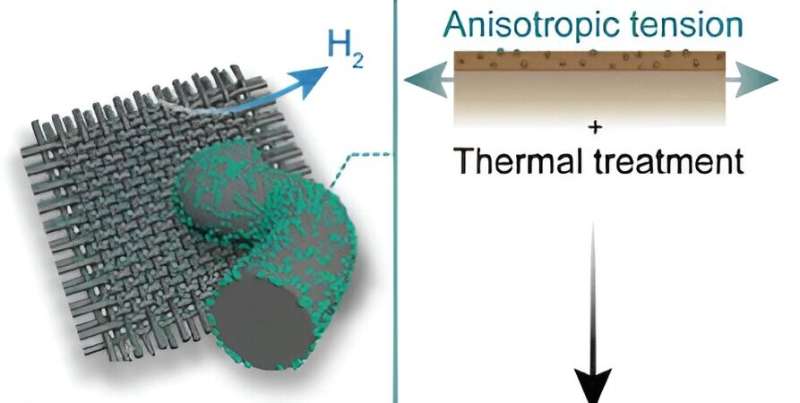This article has been reviewed according to Science X's editorial process and policies. Editors have highlighted the following attributes while ensuring the content's credibility:
fact-checked
peer-reviewed publication
trusted source
proofread
Enhancing green hydrogen production with robust carbon fabric electrocatalysts

A technology has been developed to address the limitations of current catalyst electrodes, resulting in the production of green hydrogen on a large scale and at a relatively low cost. The development is reported in the Journal of the American Chemical Society.
Led by Professor Han Gi Chae in the Department of Materials Science and Engineering and Professor Jong-Beom Baek in the School of Energy and Chemical Engineering at UNIST, the team collaborated with Professor Kafer T. Tavuz at King Abdullah University of Science and Technology (KAUST) to develop carbon fabric electrocatalysts embedded with highly functional catalysts using a conventional carbon fiber/fabric manufacturing process.
This innovative design allows for stable operation across large areas by utilizing a carbon fiber catalyst, as opposed to a powder-type catalyst that is prone to detachment. Notably, this advanced electrode boasts a lifespan 100 times longer than conventional electrodes while maintaining optimal performance through the use of ruthenium instead of the more expensive platinum, resulting in significantly reduced manufacturing costs.
Traditionally, electrochemical electrodes were manufactured by spraying a powder catalyst like carbon powder onto the electrode for fixation. However, this method posed challenges related to uneven application, leading to issues such as clumping or detachment of the powder. Conversely, carbon fiber-based electrochemical electrodes are gaining attention for their high thermal and electrical conductivity properties, as well as their ease of use across large surfaces.
Taking a step further, the research team integrated ruthenium (Ru) into the polymer precursor fiber during the manufacturing process, thereby enhancing catalyst stability. By utilizing polyacrylonitrile (PAN) as the precursor polymer, the team was able to effectively express the catalyst's characteristics in a stable manner. Moreover, ruthenium was selectively affixed to the surface as a chemical catalyst in lieu of platinum.
Their ruthenium surface–embedded fabric electrocatalysts (Ru–SFECs) demonstrated a low overvoltage of 11.9 mV at a current density of 10 mA cm–2, indicating low energy consumption during the hydrogen generation process. The developed electrode showed a negligible overvoltage increase of 6.5% even after 10,000 operations, a notable improvement over commercialized platinum powder catalysts.
The new carbon fiber electrode with a functional catalyst attached was designed to operate at a significant cost advantage compared to traditional electrodes dependent on expensive platinum-based catalysts. By utilizing ruthenium instead of platinum and incorporating it into the polymer precursor fiber early in the manufacturing process, the team was able to create Ru–SFECs with a low overpotential of 11.9 mV at a current density of 10 mA cm–2, showcasing remarkable stability and efficiency.
The team's innovative approach leverages the exceptional mechanical and electrical properties of carbon fibers, showcasing their potential as a versatile material for future electrochemical reactions. Through meticulous control of catalyst metal separation and microcarbon structure, the researchers achieved maximum stability and activity, enabling the continuous production of catalyst fibers for direct industrial applications.
"This study lays a foundation for developing stable, binder-free, and flexible electrocatalytic electrodes," stated Professor Chae. "In addition, this technique holds potential for other catalytic reactions with different metals. Future research should focus on enhancing mechanical durability, electrical conductivity, and cost-effectiveness."
This electrode not only offers energy-efficient manufacturing processes, but also reduces waste production. The research team successfully validated their findings through the commercial manufacturing process used in the carbon fiber industry.
The continuous production of catalyst-supported carbon fibers on a semi-pilot line achieved in this study represents a technological maturity level suitable for real-world implementation. "The flexible fiber form factor of this study facilitates immediate applications as an electrochemical, thermochemical, or photocatalyst," noted Research Professor Seok-Jin Kim at KAUST, Co-first-author of the study.
More information: Seok-Jin Kim et al, Scalable Design of Ru-Embedded Carbon Fabric Using Conventional Carbon Fiber Processing for Robust Electrocatalysts, Journal of the American Chemical Society (2024). DOI: 10.1021/jacs.4c00332
Journal information: Journal of the American Chemical Society





















